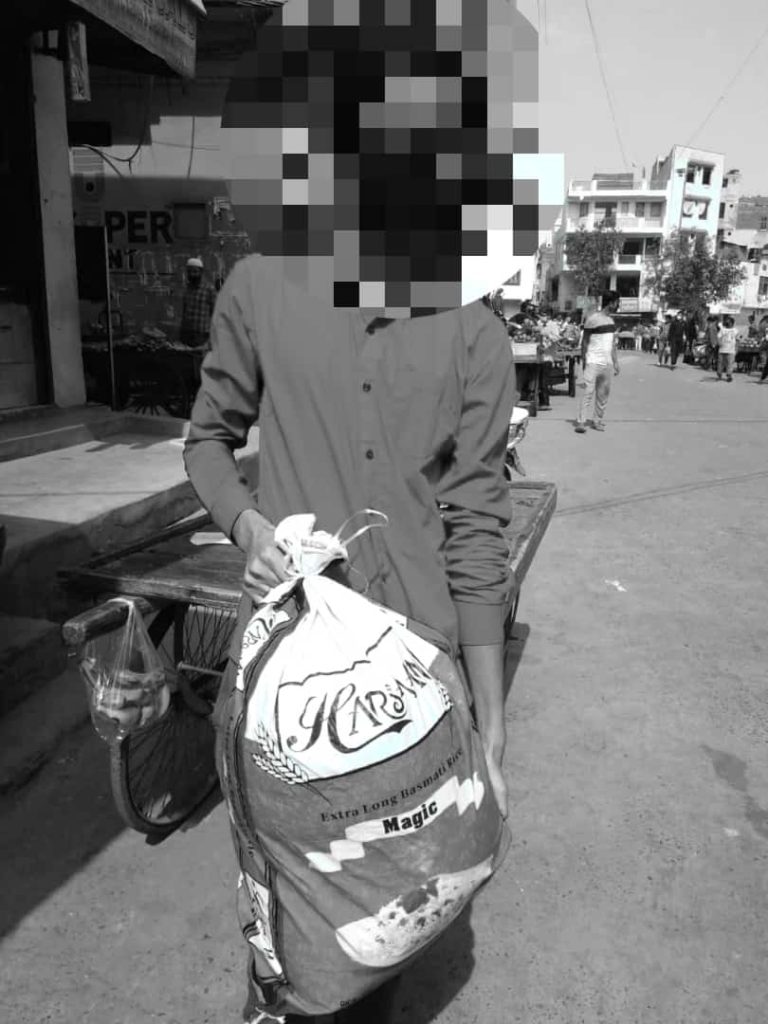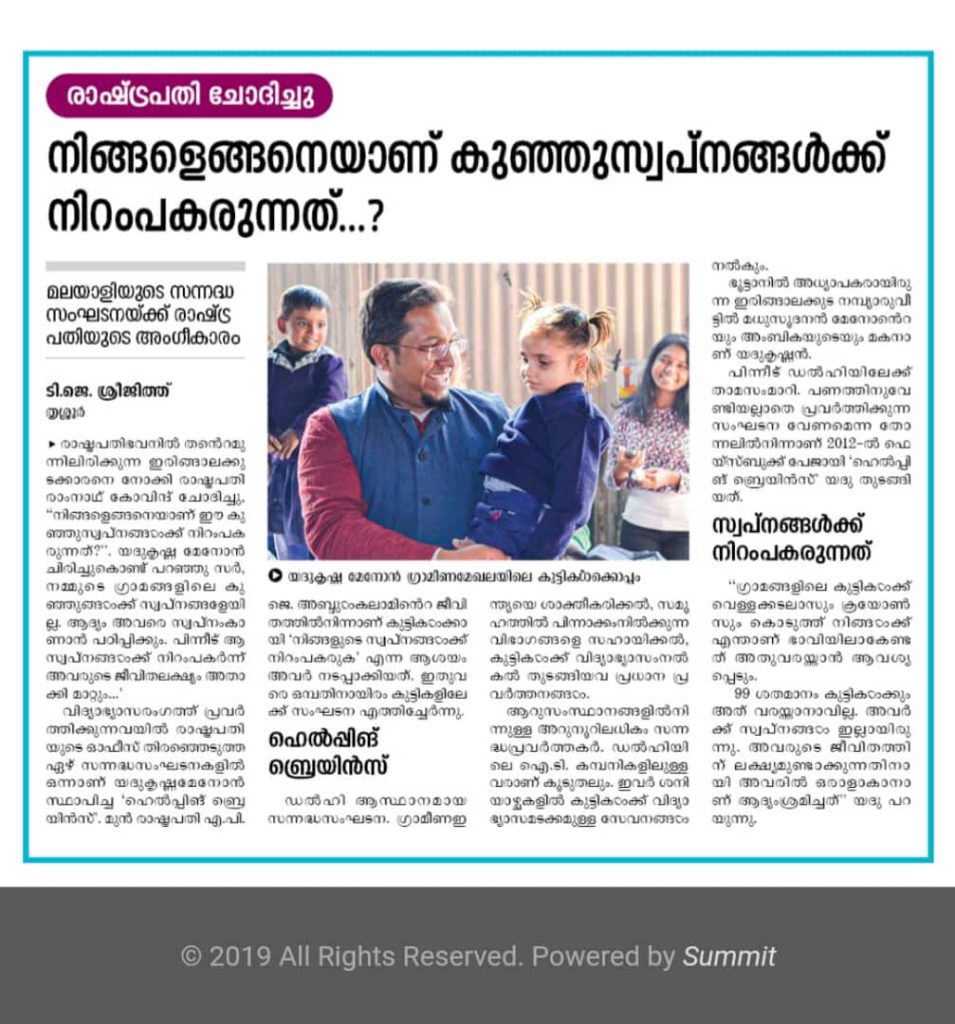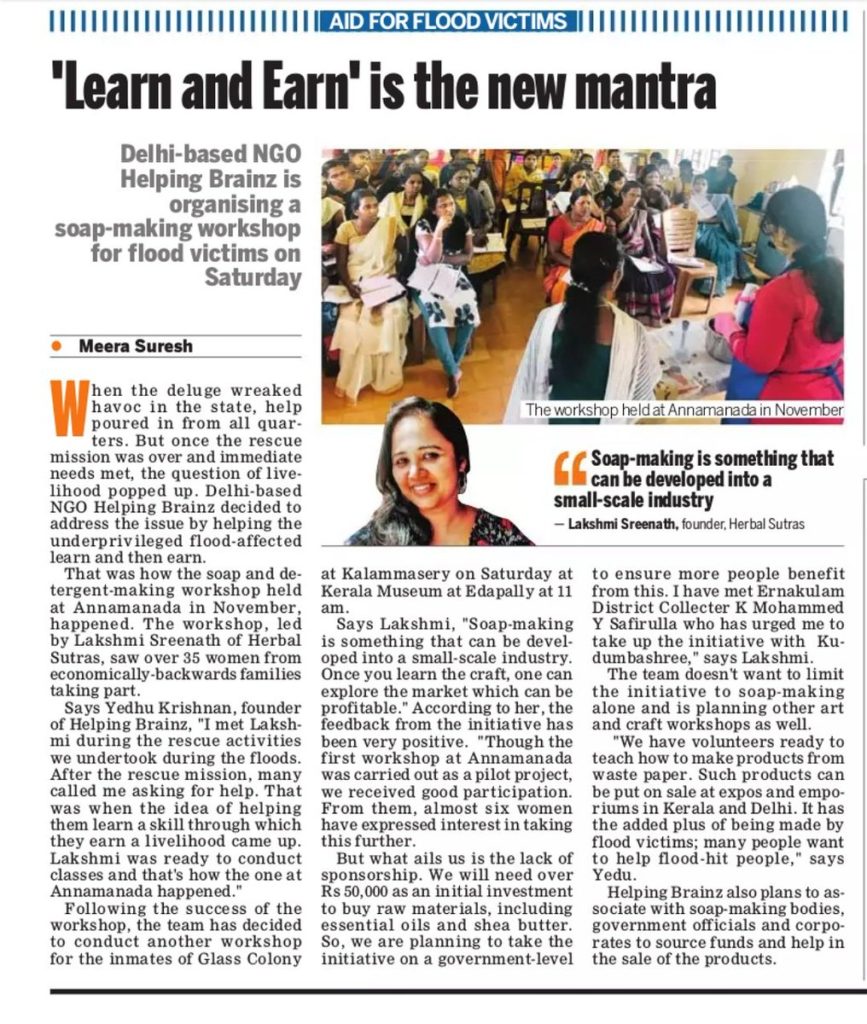Home » Bloggerati
Category Archives: Bloggerati
Role of NGOs in curbing unemployment

Youth Unemployment
The fortunate ones are those who have a permanent job that assures lifetime security. Such situations are less in number, and overpopulation has increased the tragedy of employees landing in unsecured positions. The unemployment rates have consequently peaked majorly because of the instant termination of employees from the unsecured companies.
Unemployment is posing a serious threat to the health of people and a nation’s economy and is needed to be addressed immediately.
Current Scenario of Unemployment in India
• Despite its demographic dividend and increased literacy levels, India faces youth unemployment as a major challenge for labour market policy. Young job seekers make up 49 per cent of the total unemployed in India.
• With 93 per cent of the available work provided by the informal sector, a significant number of well-educated youth in India are either unemployed, underemployed, seeking employment or between jobs, or coping with insecure work arrangements. India’s main challenge regarding youth unemployment is the lack of any form of social security system, as well as proper and adequate avenues for vocational training.
• In an environment of immense opportunities for economic growth, India requires more national as well as international cooperation among different labour market actors (trade unions, vocational training organisations, committees at the national level) to sustain it.
• Among the states and Union Territories of India, Gujarat had the lowest unemployment rate of 1.2% followed closely by Karnataka at 1.8%, Maharashtra and Chandigarh at2.8%, Madhya Pradesh at 2.9% and Telangana at 3.3% while Sikkim had the highest at 15.8%1 .In the northern India, the unemployment rate is quite high, Jammu and Kashmir at 10.5%, followed by Himachal Pradesh at 7.5%, Rajasthan at 6.5%, Punjab at 5.8%, Delhi at 5.2% and Haryana at 4.8%. According to the survey2, 49.5% persons were estimated to be self-employed under the Usual Principal Status (UPS) Approach followed by 30.9% as casual labour. Only 16.5% were wage/salary earners and the rest 3% covered contract workers. Under Agriculture, Forestry and Fishing sector, 46.9 per cent persons are estimated to be employed. It shows that majority of the workforce are employed in the primary sector. Studies also show that 41.9% employed persons are self-employed followed by 34.9% as casual workers, remaining 23.1% as wage/salaried employee and contract category worker for the age group 18-29 years.

NGOs Role in curbing unemployment
• India has nearly 3.4 Covid-19 and the Future of Youth Employment non-governmental organisations (NGOs), working in a variety of fields ranging from disaster relief to advocacy for marginalised and disadvantaged communities
• NGOs play an important role in curbing unemployment rate of the country by contributing different elements like including short-term training, where unemployed youths are educated in personal skills, e-skills and enterprise business. Moreover, it recognizes prior learning so that students can take courses that fill in the missing gaps in knowledge and offers placement guidelines to ensure candidates are assigned in a suitable field placement.
• They operate welfare programs in India focused on the “education for poor children, healthcare for families, skills training and livelihood for youth and community engagement through women empowerment,” according to their platform. In response to India’s youth unemployment rate and youth undertraining, underprivileged city youths are enrolled in the program and trained in business-relevant skills, including English communication, computer proficiency, business management and personal skills. In the last decade, more than 25000 young adults were taught these essential skills, and more than 15,000 trainees were placed with well-known companies by the program.
• To promote skill development in rural areas, Apprenticeship Training Scheme (ATP), Vocational Training Providers (VTP) and many other programmes were undertaken. Government has also decided to transform Public Employment Exchanges into Career Centers to provide guidance and career counselling to young people.
• Vocation courses are recognized as an important part of under-graduation and post-graduation collages. Government should emphasis in inculcating these courses in the primary level and makes it compulsory part of the curriculum so that people so that people become proficient in their early stage of life. Career Counselling is provided within the school and they reach all the students to guide them on choosing appropriate career related to their skills and interests.
Covid-19 and the Future of Youth Employment
All indicators that have come out paint the same picture—the great fall of our economy. Annual GDP growth for this fiscal (FY21) is expected to hit negative double digits. The gravity of this economic inactivity in terms of jobs now provides a glaring picture for everyone. Close to 94 lakh people have withdrawn Rs 35,445 crore from their EPF accounts in the last four months, up 33% from last year. This clearly indicates massive job losses or salary cuts. As per CMIE reports, salaried jobs grew by a meagre 1.6% in 2017-18, which registered a negligible growth of 0.1% in 2018-19. It has gone downhill ever since. The number of salaried jobs contracted by 1.8% in 2019-20. So, even before Covid kicked in, we were struggling to create salaried jobs. So far, during April-August 2020, we have lost close to 2.1 crore salaried jobs.
Unemployment among India’s youth population, mostly from impoverished communities, remains a challenge today. COVID-19 has shaken the Indian job market like much of the world, sending the unemployment rate as high as 24%. Yet, while unemployed youths in India remains high, the COVID-19 pandemic has led organizations to shift their efforts toward helping those in need.
For example, the Indian government has transformed several of its training centers into quarantine units. However, youths with healthcare training are being referred to the Ministry of Health and Welfare to help with the pandemic response.

Return to a pre-pandemic life will be slow. Still, when India is ready again to invest heavily in its large reserve of youths, there is a real promise for economic gain with a possible 2% future growth in the country’s economy.
HelpingBrainz as an NGO worked on the unemployment issue prevailing in India wherein team Helping Brainz created several WhatsApp groups and Telegram pages to post job opportunities. Many needy people are receiving employment opportunities through us. Helping Brainz also started various skill enhancement and career development programs in collaborations with organizations like Maclead Certifications and all.
– An article by Minakshi Thakar. Minakshi is a learning and skill development professional with a BIG4 wherein she dedicates her weekend with Helping Brainz by handling the human resource and the international peace projects.
Linking Shopkeeper-Needy Model
The conceptualizers and event orchestrators at Helping Brainz are either working IT professionals, homemakers or students wherein they don’t have any social working or disaster management background. However, they are definitely keen learners, innovators, thinkers and know how to use the desi jugaads (manage a situation with the help of all available resources) during distress. Be it, the disaster during the floods in Kerala and Assam or the present COVID19 lockdown, Team Helping Brainz used simple WhatsApp groups, Social Media integrations and Google Spreadsheets with the help of few workaholic volunteers at the same time innovative and motivated folks to deliver the goal that is helping the needy. This innovative approach from the Helping Brainz aimed to help the needy without having any of its volunteers on the ground since they considered volunteers’ safety with utmost priority.

During the lockdown, they initially started helping the needy families (like the maids/guards) who were in need. Given that the migrant population started moving homewards, the common man lost his source for daily income, the tensions started increasing – this is where Helping Brainz devised their ‘Linking Shopkeeper-Needy Model’, all thanks to Yedhu Krishna Menon, Swaminathan Lakshminarayanan and Sneha Harsh from Helping Brainz who connected the dots in the layman’s idea. Yedhu and Swami first experimented this by helping the 7 families of Ashok Nagar, Delhi through the Gupta Store and it didn’t stop there, it continued and is being continued. Helping Brainz today has helped more than 4000+ people get 7 days ration from 60+ cities in India with the help of 50+ shopkeepers, who were/are their unknown angels, without having a single volunteer on the ground. The model of work also aimed at helping the local shopkeepers who are in stress by giving them an opportunity to serve the community.
Helping Brainz Lockdown Support Team is a 25 member WhatsApp group which functions from 10 am to 7 pm in 2 different shifts because the majority of these 25 people are either working professionals or students. The team receives inputs about the needy families and migrant labourers from the NGOs, Ground Volunteers, Social Media Channels, Other WhatsApp groups (especially the Migrant Transport Network groups). These inputs are entered into the Google Spreadsheets by the Data Entry Team, followed by the validations by the Due Diligence Team (data validation team talks to each of the families understands their situations, counsel them if required, check the counts of their family members), post which the Data Quality is checked and same appears on a closed Google Spreadsheet’s Dashboard- which indirectly becomes the input for the ground team to handle each location as queued in the dashboard. Emergency cases are given priority. The ground team uses Google Maps, local contacts, to locate a shopkeeper. Sometimes the shop is recommended by the beneficiary and it is located closer to where they are. Once shopkeepers are identified, the ground team negotiates on the price and ingredients for which they are counselled and trained on the due diligence they need to perform among the families. Shopkeepers are assured that they will be paid first using any e-wallet (Google pay, Paytm, PhonePe) and then they may deliver the kits. They ensure that not more than 4 people are visiting the shops in an interval of 10 minutes to buy the goods, thereby ensuring Social and Time Distancing. Ration kits and other donations are validated by the Ground Teams using photographs and videos. Shopkeeper delivers the goods after the family member verifies himself or herself using his Aadhar card number. Along with this fact, they have established multiple checkpoints to ensure due diligence. All photographs are taken within the social distancing norms, after taking appropriate consents from the families. Faces in the photographs are blurred before they are shared with their social media channels and the donors, ensuring their privacy. Food kits are again given to families after a gap of seven days. In the initial phase, the team decided to provide the ration for a week, the reason being that the situation had been unpredictable. The team wanted to reach out to the maximum number of families with the limited fund available.
Owing to the Eid celebration, a lot of families were concerned about how to feed their starving children. In this context, Helping Brainz has played a vital role in understanding people’s emotions at the ground level as they were able to perceive the hunger and starvation the country had been going through. Additional counselling was given to labourers and migrants, along with the travel support to a few of them. All the thankful messages and calls from the beneficiaries were the primary source of motivation for the volunteers who were working continuously from the different cities of India and abroad for one cause that is ‘no matter what, no one should stay hungry.’
Helping the needy with a kit of ration would definitely not solve their problems in the long run. The team found out that the root cause of the problem is the unavailability of jobs for the migrants who are now back to their hometowns and also people who have lost their jobs due to the ongoing pandemic due to COVID-19. The upcoming project of Helping Brainz is being scheduled on providing employment opportunities for the needy and the team is actively working on the data, research and integration. Also as part of the improved health and sanitation programmes, Helping Brainz plans to distribute sanitary napkins in the rural townships of Karnataka and Jharkhand – and to conduct healthcare awareness drives in these cities.
Few key artefacts:
- Helping Brainz’s Lockdown Virtual Support Team is working with a dedicated team of 25 members working in 2 different rotations (15X7) reached out, counselled, and donated food to 6000+ people from 60 Indian cities.
- 50+ Shopkeepers connected with the help of this model and helped them run their business amidst the lockdown.
- Is working with a group of ground NGOs from Delhi NCR from a ground support perspective.
- Is working with a backend team including 90% Working Professionals and 10% of Students.
- Had there been NO volunteers on the ground considering volunteers’ safety first, however, ensured the efficient and qualitative food delivery respecting the governmental norms.
- Their approach included appropriate people-validation, due diligence mechanisms. Shopkeepers were also trained on the same.
- TAT for food delivery has been less than 2 hours for all regions (if the number of families/regions <10). TAT for food delivery has been less than 72 hours for all regions (if the number of families/regions <50)
- Only 4 members of the concerned area were allowed to visit the shopkeeper within 30 minutes respecting social distancing.
- A standard kit consists of 5 Kg of Atta, 3 Kg of Rice, 1 Kg Salt, 1 Kg Dal, 3 X 100g of Masalas.
- A Standard kit costs on an average Rs.380 and their donors found it easy to donate.
- If the family members are <4, then 1 Kit is given or if the family members are >4 and <8, then 2 Kits are given or if the family members are >8 and <12, then 3 Kits are given
- Helping Brainz always blurred all the photographs before sharing it with the donors respecting the Privacy of the families.
- Consent was taken before clicking any photographs with Social Distancing maintained.
Details of the article contributors:
- Sneha Harsh – Communications and Public Relations – Practice Head, Helping Brainz.
- Kirti Kumari Tikyani – Environmental Sustainability and Media Information Literacy Projects Head, Helping Brainz.
Baby Nagma requires your support.
Baby Nagma (5 years), daughter of Ansar and Zarina from Moradabad (Uttar Pradesh), is having a severe damage (big bulge – ill-defined lobulated right intra-orbital mass lesion in the posterior segment of the eye) in her right eye from the past 3 months. This is extremely painful and is growing day by day, and for the past few days it started smelling as well.
In the first week of June 2020, they went to AIIMS, Delhi for treatment and they were asked to go through several tests (as prescribed by AIIMS, Delhi) and they got all the tests done from the nearby private testing centers. Post the reports and results were submitted AIIMS said they cannot take the case as of now and asked Baby Nagma to come after 8 days, and the kid was not given an admission despite of the fact that she is not well at all. They hopelessly returned back to Moradabad since they were living in the footpath near to AIIMS, Delhi and it was not favourable to stay on the footpaths.
The panic created by this approach of the government hospital and since this mass is growing day by day – and kid is not able to bear the pain, the parents are thinking of approaching other government hospitals since they cannot afford going to a private hospital).
Ansar and Zarina are currently in Moradabad, and are open to go to any hospitals where their kid can get a good treatment.The kid’s family comes from an underpriviledged background wherein Ansar is a daily wage labourer. Ansar can be reached at +916398559015 and the reports can be forwarded as and when required. They are presently requesting whether if the kid can be admitted to PGI Chandigarh or any equivalent hospitals or not.
Government hospitals in India should have the continuity in the work and service delivery in case of a pandemic or anything similar. This is an example where due to the pandemic, the common man is not getting appropriate attention in the hospitals.
#DelhiTurkmanGate – LockdownDonations
Team Helping Brainz donated groceries to a 8-membered family from Kali Masjid Area, Turkman Gate. These families were starving for the past few days and were in need of groceries.
Helping Brainz Lockdown Support team appreciates Pratik Bishen and Sneha Harsh for their coordination. Complete food kits were donated and we wished the families – Happy Eid. #Respect
ImportantDays
3rd March – World Wildlife Day
4th March – World Heritage Day
8th March – International Women’s Day
8th March – Ramakrishna Jayanti
10th March – CISF Raising Day
11th March – No Smoking Day (Second Wednesday of March)
12th March – Mauritius Day
12th March – World Kidney Day
14th March – International Day
of Action for Rivers
14th
March – Albert Einstein’s Birthday
14th March – Pi Day (Pi is a Symbol in
Mathematics)
15th March – World Consumer Rights Day
15th March – World Consumer Day
16th March – National Vaccination/Immunization Day
18th March – Ordnance Factories Day (India)
20th March – International Day of Happiness
21st March – International Day of Elimination of Racial
Discrimination
20th March – World Sparrow Day
21st March – World Forestry Day
21st March – World Down syndrome Day
21st March – World Poetry Day
22nd March – World Water Day
23rd March – World Meteorological Day
24th March – World Tuberculosis Day (TB)
27th March – World Theatre Day
An article about Helping Brainz’s Child Empowerment Initiative “Paint Your Dreams” – Mathrubhumi
An article about Helping Brainz’s Child Empowerment Initiative “Paint Your Dreams” with a note on the visit to Rashtrapati Bhavan (to meet President RamNath Kovind) in Today’s #Mathrubhumi Newspaper (Delhi, Mumbai, Bangalore, Chennai, Gulf and Thrissur editions). Special thanks to Acha, and T.J.Sreejith and Shaheed from Mathrubhumi for this brilliantly written article.

Status of Education in Uttar Pradesh
Status of education in Uttar Pradesh
(Source : Firstpost, ASER)
• A fourth of Uttar Pradesh’s (UP’s) 200 million people are aged between five and 14 years – India’s largest child population – but the state has the fewest teachers per student, the poorest transition rate from primary to upper primary school and amongst the lowest learning outcomes in the country.
• UP’s literacy rate of 69.72 percent is India’s eighth lowest in the country, according to Census 2011.
• Literacy rate rose 13.45 percentage points in UP over a decade from 2001, but there are wide regional disparities: In the north-eastern district of Shrawasti, the literacy rate is 49%, while in the best performing district, Ghaziabad (in north-western UP), it is 85%, according to this report.
• UP has the worst primary school pupil-teacher ratio in India
• India’s largest state by population has the worst pupil-teacher ratio (PTR) in India, with a teacher for every 39 students at the primary level, according to the Unified-District Information System for Education (U-DISE) Flash Statistics 2015-16. The all India average is 23:1.
• UP recorded an enrolment of 25.3 million primary students (including both private and government schools) in 2015-16, taught by 665,779 teachers (even including schools where primary, upper primary and secondary co-existed), according to government education data.
• At 30 students per teacher–as prescribed by the Right to Education Act (RTE)–at the primary level, the state should have 840,000 teachers but is short by 21%, or 176,000, according to our analysis.
• UP also reported the second-highest teacher absenteeism (31%) in rural public schools among 19 surveyed states in 2010, according to this 2014 study.UP spent Rs 13,102 per elementary school student, including both primary school students (grade I to V) and upper primary school students (grade VI to VIII), according to this commentary in the Economic and Political Weekly. This is higher than the all India spending of Rs 11,252 per student.55% of students in grade III could read a grade I text in 2014, compared to 50% students in 2006; in government schools, the proportion reduced from 24% in 2006 to 13% in 2010.In UP, few attend school regularly–on average, only 55% of children enrolled were present on the days the ASER team visited primary schools in 2014, according to ASERdata.
• According to this calculation by the National Commission for Protection of Child Rights, based on Census 2011 data: 624,000 children, or 8.4% of the five-14 age group.
An article about Helping Brainz on “the Women Empowerment Initiatives we have conducted post The Kerala Floods” – The New Indian Express.
An article about Helping Brainz on “the Women Empowerment Initiatives we have conducted post The Kerala Floods” The New Indian Express. Post the flood, the conditions of the underprivileged communities were in a bad situation wherein Helping Brainz in collaboration with Lakshmi Sreenath led Herbal Sutra, conducted 5 women empowerment and entrepreneurship campaigns in various villages in the banks of Chalakudy River, which was badly affected in Kerala Floods 2018. The ‘learn and earn’ sessions mainly aimed in providing the women with an opportunity to think and create a medium for their livelihood.




















